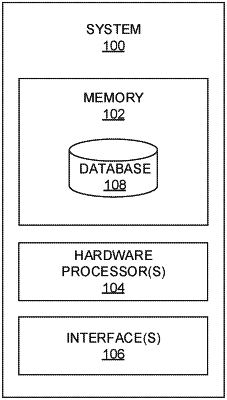| CPC G06Q 30/0271 (2013.01) [G06Q 30/0204 (2013.01); G06Q 30/0264 (2013.01)] | 12 Claims |

|
1. A processor implemented method, comprising:
receiving, via one or more hardware processors, an input data comprising information corresponding to a plurality of users, one or more associated transactions, one or more clickstreams associated with one or more items, and one or more offers;
computing, via the one or more hardware processors, a look-ahead score for at least one of a potential sale, a likelihood of churning of the plurality of users, and a subsequent user arrival window based on the received input data;
identifying, via the one or more hardware processors, a set of potential segments based on the computed look-ahead score and one or more historical scores, wherein the one or more historical scores correspond to one or more historical transactional data;
mapping, via the one or more hardware processors, each of the plurality of users to at least one potential segment from the set of potential segments;
receiving, in real-time, a trigger notification associated with one or more users;
generating a set of one or more recommended items for the one or more users by eliminating popularity bias based on the received trigger notification, wherein the set of one or more recommended items are generated by eliminating the popularity bias associated with one or more items comprised in an item catalogue and upon generating the trigger notification, one or more recent clickstream products are captured and fed into a system;
learning the set of one or more recommended items and session embeddings using a graph neural network and generating top-N products, wherein product scores are converted to offer scores using a Product-Offer mapper which a) maps offers applicable to the products recommended b) generates offer scores using (i) an offer period, (ii) remaining days left for one or more offers, (iii) a redemption rate, (iv) an item count, (v) an item leftover rate and (vi) a face value of an item;
mapping one or more personalized offers to the generated set of one or more recommended items for the one or more users, using a deciphering technique, which deciphers each offer description using Natural Language Processing techniques and classifies them into predefined list of offer types and then maps to customer segments, wherein an offer list coming out of the Product-offer mapper is personalized using a combination of the Natural Language Processing (NLP) techniques, the NLP techniques being at least one of Bidirectional Encoder Representations from Transformer (BERT), Named Entity Recognition (NER) and attribute propensity models, and the one or more personalized offers are further optimized using an optimization layer, wherein an existing customer is compared against customers in the customer segments to obtain a final assignment of the one or more personalized offers and optimized offers ;
determining a set of optimal offers based on the one or more personalized offers being mapped to the generated set of one or more recommended items, wherein sales potential of the one or more users are calculated using a deep probabilistic model which obtains input from an analytics warehouse and a neural network is trained using features derived from one or more databases; and
predicting a probability of returning customers and the sales potential, wherein a customer next purchase window is predicted using a LightGBM model and training the LightGBM model using a customer profile that is built using at least one of temporal transactional, behavioral features and static features of the one or more users.
|